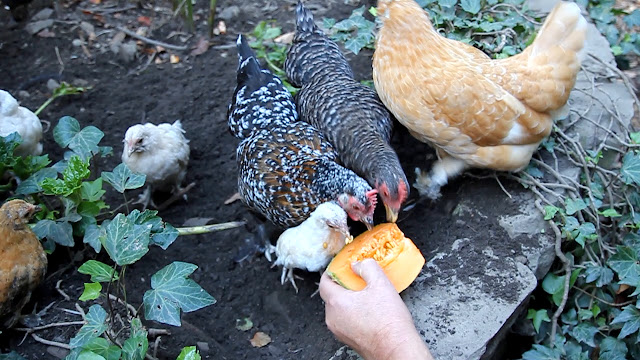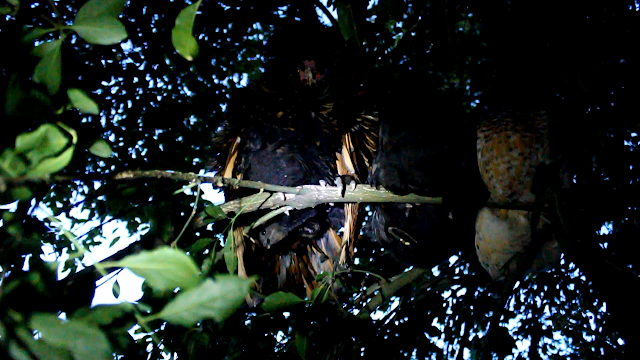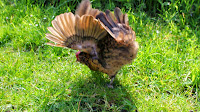I guess the most famous of my instances of co-parenting, if we are to go by viewing figures, is that of two of my neighbour's mallard mothers and a whole host of ducklings. It started out as a disaster but was turned into a triumph by the skill of our wonderful Cochin 'Pearl' and you can read about it and watch the films in full here. However, co-parenting is becoming quite a phenomena within the confines of our forest garden home and so I thought I'd look into it and discuss some of my findings here.
 However, Slippers was the one to place
herself on the lower branches and call constant encouragement as they made their way up. Whether Bunny had had
enough of sleeping on the ground or whether or not she felt they needed the safety of the
trees before the onset of the Westerlies, I can not say but it is an
interesting speculation.
However, Slippers was the one to place
herself on the lower branches and call constant encouragement as they made their way up. Whether Bunny had had
enough of sleeping on the ground or whether or not she felt they needed the safety of the
trees before the onset of the Westerlies, I can not say but it is an
interesting speculation.
 At one point I thought the biological chicks of Bunny were more drawn to her but although it was sometimes the case that the two hens roosted on different sides of the Bay tree and that sometimes Chamois chick or chicks followed her, this was by no means the norm. As the chicks advanced in both age and skills, the mothers went higher up the tree and now roost together with the chicks tightly packed beneath them. As we head into Autumn/Fall, it can be pretty hairy up there if there is a stiff wind blowing from the sea and both mothers strategically placed on the Eastern branches of the Bay tree can make a formidable wind break! The motion of the tree at these times makes me think of a cradle with the two mothers rocking gently at either side.
At one point I thought the biological chicks of Bunny were more drawn to her but although it was sometimes the case that the two hens roosted on different sides of the Bay tree and that sometimes Chamois chick or chicks followed her, this was by no means the norm. As the chicks advanced in both age and skills, the mothers went higher up the tree and now roost together with the chicks tightly packed beneath them. As we head into Autumn/Fall, it can be pretty hairy up there if there is a stiff wind blowing from the sea and both mothers strategically placed on the Eastern branches of the Bay tree can make a formidable wind break! The motion of the tree at these times makes me think of a cradle with the two mothers rocking gently at either side.
Sacagawea and Bella are still working as a cohesive team, they do not seem to have different duties and unlike the calmer Slippers, both she and Bella are equally as protective and one might even say aggressive in the protection of the chicks.
I am amazed how these hens decided on the changes to be made in the parenting of these two chicks. Furthermore, how seamlessly it has happened without apparently any perturbation to the chicks.
Here's the film:
Until next time, all the very best from Normandie! Sue
© 2018 Sue Cross
Why Co-Parenting?
If I were to analyse why co-parenting seems on the rise this year in the forest garden, then I might proffer as hypotheses; the heatwave, resultant drought and their attendant factors of leaf-drop and paucity of soil-dwelling invertebrates. As the latter go deeper, the overhead predators have also profited from the former, with a clearer view of the forest garden floor. Furthermore and much to my annoyance, scavenging rats have decided that although, due to our intervention, they can not live with us they can surely make marauding raids over the garden in the late evening and early mornings. Birds have good memories, in my experience and last year's cold Spring and poor Summer resulted in slow leaf growth, which allowed the hawks flight paths within the forest. We sadly lost several chicks before we realised what was going on. All these factors, apart from the reason that it is probably more fun to have company whilst sitting eggs, have made for a bumper co-parenting season.Four Eyes Good!
It is very obvious in certain co-parenting relationships as to the division of labour. Looking at the above photograph, you can see that 'Bunny' the Chamois Polish cross hen has the role of lookout and protector, whereas 'Slippers' the Cuckoo Cochin cross hen is the food provider and teacher of foraging. This role has continued throughout the Summer and although it now seems obvious that the eggs were from both hens, they have continued to co-parent all the chicks regardless of bloodline. At this point in the chicks' growth, the Mothers have given them more liberty and remain in the background when food is easy to come by i.e. from me, although Bunny is still, on guard! Bunny was the first to decide it was time to roost.
 However, Slippers was the one to place
herself on the lower branches and call constant encouragement as they made their way up. Whether Bunny had had
enough of sleeping on the ground or whether or not she felt they needed the safety of the
trees before the onset of the Westerlies, I can not say but it is an
interesting speculation.
However, Slippers was the one to place
herself on the lower branches and call constant encouragement as they made their way up. Whether Bunny had had
enough of sleeping on the ground or whether or not she felt they needed the safety of the
trees before the onset of the Westerlies, I can not say but it is an
interesting speculation. At one point I thought the biological chicks of Bunny were more drawn to her but although it was sometimes the case that the two hens roosted on different sides of the Bay tree and that sometimes Chamois chick or chicks followed her, this was by no means the norm. As the chicks advanced in both age and skills, the mothers went higher up the tree and now roost together with the chicks tightly packed beneath them. As we head into Autumn/Fall, it can be pretty hairy up there if there is a stiff wind blowing from the sea and both mothers strategically placed on the Eastern branches of the Bay tree can make a formidable wind break! The motion of the tree at these times makes me think of a cradle with the two mothers rocking gently at either side.
At one point I thought the biological chicks of Bunny were more drawn to her but although it was sometimes the case that the two hens roosted on different sides of the Bay tree and that sometimes Chamois chick or chicks followed her, this was by no means the norm. As the chicks advanced in both age and skills, the mothers went higher up the tree and now roost together with the chicks tightly packed beneath them. As we head into Autumn/Fall, it can be pretty hairy up there if there is a stiff wind blowing from the sea and both mothers strategically placed on the Eastern branches of the Bay tree can make a formidable wind break! The motion of the tree at these times makes me think of a cradle with the two mothers rocking gently at either side.
It seems to me and in fact has done so from the outset that these two mothers have co-parenting down to a fine art, their's is the best example I have ever seen of planned division of labour. Each hen seems to be aware of her personal strengths and weaknesses as a mother. Bunny is a lot more of a 'Tiger Mother' being more distant and yet more protective of the chicks and Slippers is the 'Lion' very nurturing and yet keen to be included within the flock.
In another coop (and coup), three mothers sat on two eggs but when they hatched the two black plumaged mothers took over the chicks. However, 'Opal' always remained in the background and was actually responsible for helping and encouraging the chicks to climb the little plank provided for them to access the chicken coop at night. Waiting in the wings was another broody, Bunny's daughter 'Sacagawea'. Eventually she gave up sitting on her wooden egg and either replaced or ousted one of the black mother hens, 'Cemani' and installed herself as co-parent along with Bella, the only remaining original sitter. Far from being confused the chicks seemed fine with this arrangement and the ex-mothers seemed fine with it too.
From time to time though, as often happens here, there has been a 'suitor' who has lined himself up to be included in the ménage. This seems to fit in with behaviour observed in those earlier wild Jungle fowl studies referred to above, where young males would 'squire' females with chicks even though they were not the original male of the pair bond. This cockerel pictured above (Chamois Polish) didn't pass the test, being less interested in looking after the chicks and more in sharing any extra food that came their way!
From time to time though, as often happens here, there has been a 'suitor' who has lined himself up to be included in the ménage. This seems to fit in with behaviour observed in those earlier wild Jungle fowl studies referred to above, where young males would 'squire' females with chicks even though they were not the original male of the pair bond. This cockerel pictured above (Chamois Polish) didn't pass the test, being less interested in looking after the chicks and more in sharing any extra food that came their way!
 |
I am amazed how these hens decided on the changes to be made in the parenting of these two chicks. Furthermore, how seamlessly it has happened without apparently any perturbation to the chicks.
Further Musings on the Reasons Behind Co-Parenting
In the ideal Forest Environment, I believe chicks would expect to have a bonded pair of parents and that their time as 'chicks' would extend for a period much longer than that expected by modern farming or backyard keeping. The time-period mentioned for brooding is around three months. This subject and pair-bonding are discussed in several early 20th century studies on wild Red Jungle Fowl in Burma and India and later in a non-confined population, released in 1942 into the 40-hectare grounds of San Diego zoo. (You can find an introduction and links to the academic studies reference here) In default of the required number of males in this garden to form pairs, or maybe more likely because not all my males have yet rediscovered their parenting skills - hens form other alliances and bonds to help them both find food and protection in the garden environment. This also happens because the forest provides a milieu within which chicks can be free-ranging from day of hatch. I am very keen on facilitating this for chicks not only to obtain the volume and quality of nutrition to grow and flourish but also the time necessary for acquiring the skills to feed themselves. I have observed too that the length of brooding is an important factor in the individual chick's emotional development. Thus I am very interested when, as has happened over recent years, if a mother loses interest in or has lost the connection to lengthy brooding, another broody from the same flock has taken over the job.
As far as the males are concerned, many do show tendencies after hatch to help with certain aspects of brooding, particularly in protecting the chicks from predators or in keeping other adults away from key foraging sites, such as the compost bins! However, witness the photographs above and below, some males take this process much further and become fully bonded to both females and chicks, in the case of Spike and Millefeuilles, this has been a long bond, six years now and although Millefeuilles sat with her friend it is the bonded male Gold Black-laced Polish Spike who looks after the chick at night (see if you can spot the little face peeking out from underneath the cockerel's feet).
Human Co-parent?
On one occasion when one of my small Polish chicks had a serious case of hypothermia and I was worried he would not make it through the day, I took on the role of parent. It is something I am very wary of doing as I do not like to in any way alter the bond with the mother but in this case it was a necessity and I'm happy to say it was a successful operation with Ringo Bingo Jr returning to his mother within 2 days and with no apparent damage either physical or emotional!In Conclusion
The Forest environment is a great place to bring up chicks, it's full of food and forage and a place to learn skills and behaviour, which makes for an even stronger and more cohesive future generation. On the downside the forest can hold dangers, similar to the ones these chicks wild cousins faced within their Jungle home but it is to my continuing admiration that the present generation find ways and means to overcome them.Here's the film:
Thanks for dropping by and do feel free to share experiences or ask for further information in the comment section. If you have enjoyed this piece and found it
useful think about sharing it with your family and friends, on social media and also maybe about joining this blog
and/or subscribing to my Youtube channel or even supporting us on
Patreon or
It all helps to keep me going!Until next time, all the very best from Normandie! Sue
© 2018 Sue Cross
RELATED ARTICLES

Broody adopts chicks in cold weather.
Some times people comment in surprise on my films that a hen will raise
anything but her own eggs but this is only half the story...read more
The case of the unhatchable egg
How importance is exact temperature in hatching an egg? A look at
broodiness, Aesop and the marvellous surprises nature has in store...read more
What to do when a duck deserts on day of hatch
One of the unwritten rules of reciprocal homesteading is that animals or
birds always choose the time you are away to have a crisis! read more


























